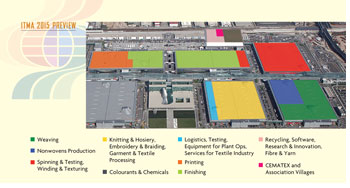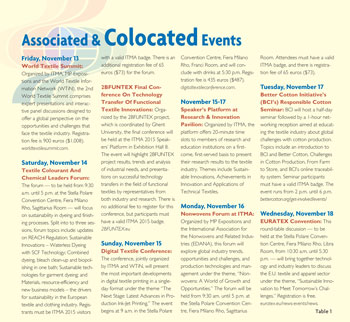The Germany-based DiloGroup reports: “During the year, there has been a great demand for Dilo lines for the production of needle felts. An above-average order intake from the important markets has been registered.”
DiloGroup presents its machines and production lines in the field of complete staple fiber nonwoven production lines. This includes fiber preparation — opening and blending — from DiloTemafa, card and card feeding from DiloSpinnbau, and crosslapper and needle looms from DiloMachines.
At ITMA, DiloGroup will exhibit two complete lines to show the full extent of its product range.
The first is a wide-width staple fiber needling line for technical textiles production, which is especially suitable for producing geotextiles according to Dilo. Fiber preparation begins with the latest-generation BTDL bale opener from DiloTemafa for processing longer fibers. The subsequent carding willow KW combines in the preopening stage “good pre-blending and preopening with highest throughput,” reports Dilo. According to the company, new design elements allow longer cleaning intervals with reduced cleaning times. Dilo’s DON dosing opener feeds the fibers viaits fine opening stage to the newly developed card feeder type VRS-P.
New Card Feeder
The new UniFeed VRS-P card feeder “combines the principle of volumetric precisely charged feeding, with the characteristics of a vibration chute feeder and eliminates a conventional large trunk (on the top),” reports Dilo. This results in a better and more homogeneous distribution of the fiber flocks, according to the company. The lower profile results in reduced costs for the construction of the factory and its operating expenses because the ceiling height can be lowered. The fiber flock matt is condensed by a vacuum delivery apron for a better uniformity of the fiber mass distribution. Additional flaps control the fiber distribution over the working width. VRS series card feeders are used for medium-fine to coarse, and medium to long staple fibers.
New Card Series
Dilo reports its new VectorQuadroCard “incorporates a completely new modular transfer group between breast and main section. The flexible and quick change of this transfer group makes possible three different card types:
Type VQ-Q with a Quattro group to improve web evenness and fiber blending, arranged as a double transfer between preopener and main cylinder with two doffers and two transfer rollers to the main cylinder.
Type VQ-V with a top doffer together with a transfer roller and a lower transfer roller to increase the throughput by using the doubling effect between preopener and main cylinder.
Type VQ-T with only one transfer roller between preopener and main cylinder.
The model series VQC uses 4 worker/stripper pairs of rollers on the preopener and five worker/stripper pairs on the main cylinder.”
According to Dilo, the delivery system is flexible and may be combined in multiple variations including: two doffer rollers and respective parallel delivery system; featuring pairs of doffer rollers and condenser rolls top and bottom; or as random card with random rollers, doffers, condenser rolls and take-off rollers.
At ITMA, a VQC with a working width of 3.2 meters designed for the geotextile sector will be on display.
New Crosslapper
According to Dilo, the new Super-DLSC 200 crosslapper operates at electro-mechanical speeds of up to 200 meters per minute for web infeed speeds, depending on the fiber used. The machine was developed with the aim of reducing a possible bottleneck for the total throughput of the complete installation. At the crosslapper infeed, Dilo has incorporated the CV1A web regulation system for improved needlefelt evenness with a great potential for fiber savings. “This high web infeed speed has been made possible by a further increase of the drive power within the 3-apron-layering technology,” reports Dilo. “All drives for the aprons and the layering carriages are direct water-cooled torque motors to improve the acceleration with reduced gear wear. In addition, special measures were taken to eliminate and reduce apron vibrations in order to achieve an exact web overlapping (lap joints).” The FLS web guiding system also was installed to help eliminate wrinkles at the speed change of the upper carriage. The reported web infeed width is 320 centimeters (cm) and the layering width is 700 centimeters.
DI-LOOM AB
Dilo will exhibit the DI-LOOM OD-II AB with CBF feeding system. Special emphasis was paid to cost effectiveness in this preneedling machine, and Dilo reports DI-LOOM AB has a very favorable price-performance ratio.
DCL Dilo-Compact Line
Dilo will exhibit a compact line designed to produce of small amounts of high quality felts suitable for use in the medical sector, and for specialty felts made from fibers such as carbon. The working width of the compact carding machine is 110 cm, the layering width is 220 cm.
X22 Needle Module Technology
The compact line needleloom is the first Dilo needleloom to use needle modules. The technology was designed for the intense needling of the Hyperpunch and Cyclopunch models in order to allow an economic needle insertion of these boards with more than 20,000 needles/m/board. The compact needle loom shows the module technology in a classical fishbone arrangement, each module comprising 22 needles. Development work on the needle modules will be completed over the coming months, according to Dilo.
Dilo-Variopunch VPX 2020
New Variopunch technology is based on a modified needle module technology that can erase bad spots in the felt using a variable needle arrangement. Dilo will utilize graphic simulations to illustrate the basics of VPX200 needling technology at ITMA. The company reports Variopunch allows homogeneous distribution of stitches for better surface quality for automotive applications. Numerous needlefelt samples for many different applications will be presented at ITMA.
The DiloGroup is in Hall 3, Booth C104
September 23, 2015






